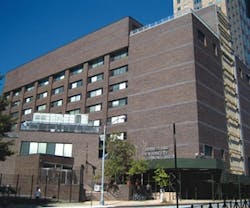Aesthetics is one reason to undergo a recladding project. While structural issues were also a concern in the decision to reclad New York City College of Technology's (NYCCT) Voorhees Hall, in Brooklyn, NY, the decision to reclad in glass was partially due to the dramatic change in the building's appearance – making it aesthetically appealing and fitting for a building that holds students of technology.
"The building was very tired and dated looking – very brutal looking and not an inspiration for students to go to work in. Now they're going to have a very high-tech looking image for a college that teaches technology," explains Hagen Scutt, AIA, senior architect and project manager for Der Scutt Architect. "We originally presented CUNY (City University of New York) and the college with three different options: a brick reclad, a reclad with a tile-type rainscreen system, and then a curtainwall. They decided that the curtainwall would be the biggest aesthetic change and was fairly economical. It was primarily an aesthetic choice to go with the bigger dramatic visual change – it is a total transformation of the building." While the main, 8-story portion is receiving a new glass curtainwall, the low-rise portion is being reclad with a ventilated rainscreen tile facade.
Redoing a Recladding
A unique complexity of the Voorhees project is that the building had already been reclad with brick in the 1970s. As energy was a prime concern during that time, many windows and other openings were closed up and the building was reclad with brick. Unfortunately, part of the facade is falling off the building – requiring the recladding to be stripped and replaced.
While the building is occupied, the brick is being stripped off and then a new curtainwall is being added onto the 8-story portion of the existing building. "What is interesting about the project is that we're taking off a reclad to put up a new reclad," explains Scutt. "The brick is unstable, the anchors are not seismically braced, and they already had to remove several portions of the existing brick facade before we started our construction because they were unstable and in danger of falling into the street. Primarily what was driving the recladding was a need to replace the envelope and then that led to the availability to do some upgrades."
Weather the Storm
Because the project began this June and is scheduled for a 2012 completion, the team needs to protect the building from the elements during the construction phase. "One of the tricks is to make the building watertight," says Scutt. "Between the time that we take the brick off and the new curtainwall goes up will be about a year. One thing that we're doing is being very cautious in terms of protecting the envelope of the building so that as soon as the brick comes down we're installing sheeting in the openings and providing an impermeable weather barrier over the entire facade – essentially we're weatherproofing the entire building for the duration of the year that the building will be open before it receives the new curtainwall."
While protecting the building from weather may be a concern during the recladding process – especially while the building remains occupied – in some buildings the new glass facade may actually shield the original facade from the elements, serving as a weather barrier. "In the case of recladding a building with glass only – let's say by attaching glass panels – it may be for the sake of providing an aesthetic change, and it also may be for the sake of providing a nominal barrier against some of the components of the weather. One of the main functions is as a weather barrier," says Russell H. Davies, P.E., senior project manager at Simpson Gumpertz & Heger Inc.
"If you have an existing facade that leaks, that has bad insulation performance, that has bad condensation performance, and/or doesn't conduct water off the building in a way that works for the site conditions or location, it may be beneficial to have a new glass and metal enclosure that deals with all of those things – that replaces or augments the insulating performance of the building enclosure, that safely (and to the material benefit of all of the components) conducts water off the building, and that is well enough thermally broken that there won't be condensation between the existing facade and the new facade or within the existing facade," he explains.
The decision to reclad with glass can have multiple benefits – including credibility in the case of Voorhees Hall, according to Scutt. "The design projects a new image of high technology and enhances the credibility of NYCCT's long history as a superior technical college."
Kylie Wroblaski ([email protected]) is associate editor
of BUILDINGS.
